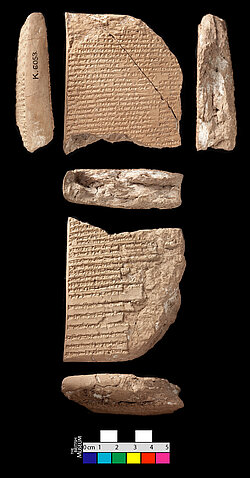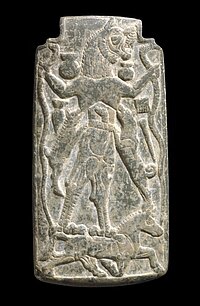Tablets & Libraries
TABLETS & LIBRARIES, SOURCES & GENRES
Cuneiform tablets
Clay tablets inscribed in the cuneiform script are the main (though not the only) sources that provide information on the ideas and concepts associated with magic and witchcraft in ancient Near Eastern societies: Letters give insight into the correspondence between kings and their scholars, supplying particulars on quarrels and conflicts that ended in witchcraft accusations. Legal texts, such as law collections, documents, loyalty oaths and treaties, shed light on which ritual practices were prohibited and how their performance would be punished. Lexical texts give important information on the terminology for magic and witchcraft in the various ancient Near Eastern languages. Myths contribute to a better understanding of the role the gods play in magic rituals.
But, and this is true for all ancient Near Eastern societies, the most significant and numerous relevant sources are ritual instructions, prescriptions and incantations that were recorded and copied by ritual experts or other scribes who added them to their private libraries or produced new copies for larger, usually royal, tablet collections.
Private tablet collections, royal libraries
Many tablets that were found in the context of private libraries were written by younger scribes, who copied the professional lore as part of their training. A typical example is the Neo-Assyrian library recovered in the so-called ‘house of the exorcist’ in Neo-Assyrian Ashur (seventh century BC). The tablets in the royal libraries, most famously the tablet collections of Neo-Assyrian Nineveh and of Empire-period Hattusa, were usually written by fully trained scribes who worked under supervision and often used multiple sources; the creation of these libraries involved systematic collecting, textual editing, the requisition of tablets and the recruitment of experts.
The lore of the exorcist
Sumerian and Akkadian ritual and incantation texts were associated in ancient Mesopotamia (Babylonia in southern Iraq and Assyria in the north) with one specific profession, an expert called in Akkadian āšipu or mašmaššu, conventionally translated as “exorcist”; the body of texts itself could summarily be referred to as āšipūtu “exorcistic lore” or, simply, “magic”. Babylonian tradition considered this corpus of texts to be of great antiquity, ultimately authored by Enki-Ea himself, the god of wisdom and exorcism.
The earliest incantations attested in cuneiform writing date to the mid-third millennium BC. They are composed in Sumerian or archaic forms of Akkadian and were excavated at Babylonian sites and at Ebla in northwest Syria. The sizable body of Sumerian and Akkadian incantations and rituals dating to the late third and early second millennium already prefigures thematically, and in many cases textually, what would become the standard repertoire of āšipūtu, but the formation and organisation of the canon of serialised texts took place mostly in the later second millennium.
Transmission & Serialisation
Even though the body of Sumerian and Akkadian incantations and rituals in the first millennium had reached a certain canonical stability, which is apparent in the similar composition of the libraries of this period, the redaction and serialisation of texts continued, and some text-groups seem to have been organised in a comprehensive series for the first time by the seventh-century scholars of the Sargonid kings of Assyria.
The texts continued to be copied well into the Seleucid period, before the cuneiform tradition finally came to an end during the Parthian reign over Babylonia. Of course, many text series and individual texts of the āšipūtu corpus are only preserved in fragments or not at all. Larger cuneiform tablets rarely survive intact, and in addition to clay tablets wooden or ivory writing boards were in widespread use, nearly all of which have perished. Parchment was used as a writing material in first millennium Mesopotamia, but probably for writing the Aramaic alphabetic script, which would only exceptionally have been used for writing Sumerian or Akkadian magical texts.
Genres
The main principles of organisation that structures the body of exorcistic rituals are aetiology, i.e., the source or cause of the evil that was to be dispelled, and purpose, i.e., the objectives and goals of a ritual. Besides therapeutic rituals that would be performed on someone already affected by an evil, there are apotropaic ceremonies that could be used preemptively; sometimes the two types of rituals are difficult to distinguish. Ceremonial rituals that include offerings, prayers, incantations and an array of symbolic actions stand next to short, simple procedures and prescriptions for potions, ointments, fumigations and amulets. Thematically, the main text groups may be summarised as follows:
- anti-witchcraft rituals: against suffering that is diagnosed to have been caused by witchcraft;
- anti-ghost rituals: against the ghosts of deceased that haunt someone;
- rituals against demons: for dispelling various demons or groups of demons (e.g., Lamaštu or Ardat-lilî);
- rituals against curse: for dispelling the evil consequences of breaking a taboo (e.g., breaking an oath, but also other crimes and sins, or even unintentional contact to someone who has broken a taboo);
- rituals against bad omens: for undoing an imminent evil that has been indicated by bad portents;
- rituals against divine anger: for soothing angry and distant deities, specifically the personal protective deities of a person.
The purification of the patient whose suffering was interpreted as a state of impurity and being bound plays an important role in most of these.
© Daniel Schwemer 2014 (CC BY-NC-ND license)







